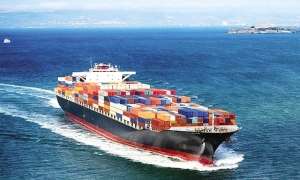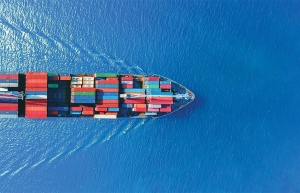INTERNATIONAL INVESTMENT
AND PORTAL
After two and a half months of continuous increases, freight rates decreased slightly over the recent weeks, partly due to increased shipping capacity and a sharp drop in demand from China to the US.
 Cooperation vital to tackle shipping rates, illustration photo/ Source: Shutterstock
Cooperation vital to tackle shipping rates, illustration photo/ Source: Shutterstock
According to data from the Phaata logistics exchange, the shipping route from Asia to North America was charging $7,746 per 40-foot equivalent unit, down 2 per cent compared to previous weeks in July. East-West shipping routes have seen a decrease of 1-4 per cent.
Despite remaining high, this decline may signal that the peak pressure on freight rates has passed. As demand eases on major trade routes, capacity may shift back to lower-volume routes, leading to further price reductions. Many forecasts are cautious about future sea freight rate fluctuations, citing variables such as ongoing tensions in the Red Sea region and demand for goods during year-end holidays.
“Currently, the decrease is so small, and the trend is unclear. Rates may cool down in August but could rise in September,” said Bui Van Kieu, CEO of Logistics Management Co., Ltd.
The Vietnam Logistics Business Association indicated that the downward trend in prices would not last long due to the big gap between supply and demand. The global fleet supply is currently decreasing by about 5 per cent due to the impact of the conflict in the Red Sea.
To address the long-term challenges of high freight rates, port congestion at some Asian ports, and a lack of empty containers affecting Vietnam’s import and export goods, Minister of Industry and Trade Nguyen Hong Dien sent a letter in July to Turgut Erkeskin, president of the International Federation of Freight Forwarders Associations (FIATA), requesting cooperation and support.
The minister hopes the FIATA will support enterprises with practical measures to overcome the difficulties caused by rising sea freight rates, port congestion, and a shortage of empty containers. He also asked the FIATA to share experiences and solutions that other countries and member associations have applied to manage additional fees beyond port charges.
“Within its influence with other international organisations related to import and export, logistics, and supply chain management, Vietnam should be prioritised in terms of means and equipment for import and export,” Minister Dien suggested.
In addition, the Ministry of Industry and Trade (MoIT) issued a document requesting import and export industry associations, logistics associations, and enterprises to coordinate in implementing solutions to accelerate import and export amidst high sea freight rates.
The ministry suggested that enterprises develop production, business, transportation, and import and export plans as a foundation for signing long-term contracts with shipping lines to minimise the impact of current high freight rates and surcharges.
“Goods should be divided among various transport routes. In addition to the current sea route, import-export enterprises with Europe should consider alternative routes, including combined multimodal transport routes, going by sea to ports in the Middle East, then by air, rail, or road to Europe,” the MoIT said.
In addition to government solutions, import-export enterprises have proposed various ways to cope with high freight rates, including seeking new export markets to reduce dependence on traditional markets.
Since the end of the first quarter, DONY Garment has shifted focus to the Southeast Asian market, including Singapore, Indonesia, Malaysia, and Cambodia. “These markets are highly competitive but offer favourable logistics. Shipping costs and times are very suitable, and some are even cheaper than domestic shipping. This is a reasonable choice in the current context,” said Pham Quang Anh, director of DONY.
Pro Sports Company in Hanoi noted that the cost of shipping a shirt to the US and European markets, which was only 7-10 per cent a year ago, has now risen to 15-20 per cent. Faced with freight rates doubling or tripling on-year, exporters are considering negotiating with customers to share shipping costs.
General director Tran Thi Ha said, “In the short term, we will also negotiate with customers to share shipping costs and consider adjusting prices for upcoming orders.”
Seasonal agricultural products and perishable fresh foods, often tied to short-term contracts, are also significantly impacted by high freight rates. These exporters are trying to cut costs to reduce selling prices and cut profits to maintain customer numbers and market stability.
“Instead of seeking distant markets, we are now focusing on short-distance markets to cut costs and losses, such as ASEAN regions, Japan, South Korea, and China,” said Nguyen Thi Thu Hong, general director of Ameii Vietnam JSC, an exporter of agricultural products.
The priority for most exporters is to negotiate with customers and partners to share risks, expedite orders, rearrange production plans, and target reasonable markets.
The MoIT said most businesses exporting key Vietnamese products, such as textiles, footwear, and wood, have full orders until the end of the year. However, as their main export markets are Europe and America, coordination and progress updates are necessary to balance freight rates appropriately.
Despite much support and advocacy from ministries, agencies, and associations, businesses note that signing long-term contracts with shipping lines and changing shipping routes still depend on international factors, such as shipping lines and global shipping flows. Therefore, negotiations with partners are not always successful.
Tran Thanh Hai, deputy director general of the MoIT’s Foreign Trade Agency, said, “The shipping costs should be shared between shippers, exporters, and buyers.”
In mid-July and the preceding months, according to Drewry statistics, container freight rates from Asia to Europe and the US saw the most significant increases. However, rates from America and Europe to Asia and intra-Asian routes remained stable.
Exporters reported that the price per container to Europe fluctuated between $4,000-5,000, several times higher than at the end of last year. The average freight rate for each container exported to the US was about $6,000-7,000, double that of the same period last year.
 Shipping costs continue to climb
Shipping costs continue to climb
Rising logistics costs are eroding profits and forcing exporters to freeze orders, as well as revealing inadequacies in the management of foreign shipping companies operating in the waters of Vietnam.
 Shipping tickers prove lucrative
Shipping tickers prove lucrative
Uptrend freight rates, high demand for freight transport, and falling fuel prices are likely to boost shipping firms’ profits in the second half of 2024, as well as creating appeal for this ticker group.
 Shipping dock squeezes inflicting domino effect
Shipping dock squeezes inflicting domino effect
Shipping to Vietnam’s key export markets is facing congestion in regional ports, with exporters encountering ever more challenges.
 Keys to solving Southeast Asia’s shipping gridlock
Keys to solving Southeast Asia’s shipping gridlock
Ongoing congestion at Singapore’s container port has impacted the shipping industry’s peak season this year. Vu Nguyen Hanh, editor of Vietnam Briefing at Dezan Shira & Associates, analyses the opportunities and challenges for Vietnamese ports, as well as their alternative solutions.



















